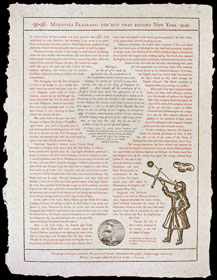Deconstructing Elsie
Deconstructing Elsie
Deconstructing Elsie
15.125 x 20" Single sheet broadside. Printed letterpress on handmade paper using Caslon typeface. This broadside recounts the convoluted tale of how nutmeg, more precious than gold in 17th-century Europe, played a major role in England's prominence in the New World. Jessica Spring: "The nutmeg tree produces fruit which can be boiled for jam. Inside is a core or 'nut' covered with a crimson, lacy covering called an aril. This is removed from the nut and dried in the sun to produce mace, which has a light, delicate flavor. The core inside is also dried, then cracked open to extract the nutmeg, which is best used when freshly grated. "Dutch traders used a lime solution to sterilize nuts before export to protect their monopoly. Transportation was further complicated by the trees' gender: male and female varieties are difficult to identify and at least one male tree is required for every seven females to produce fruit. Nutmeg was believed to provide magic powers, especially in the art of seduction. "Born in 1692 in England, William Caslon apprenticed to an engraver of guns, eventually opening his own shop to cut type for bindings and binders' tools. The majority of English printers used type from Dutch foundries until Caslon's production in 1722 of a roman, italic, and Hebrew font. His famous specimen of Caslon produced in 1734 eventually spread their use 'internationally, most notably to print the Declaration of Independence." |
